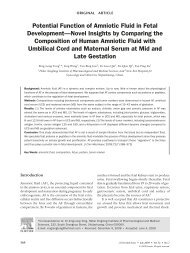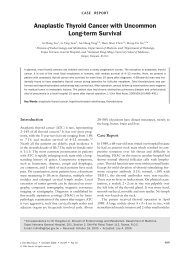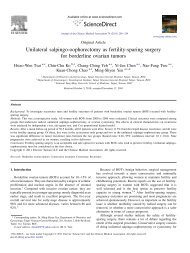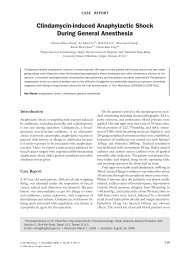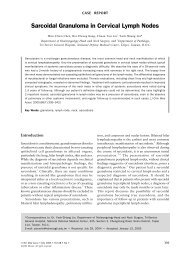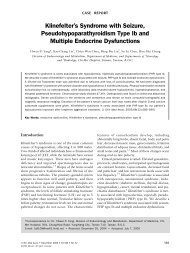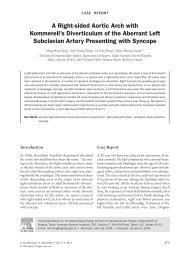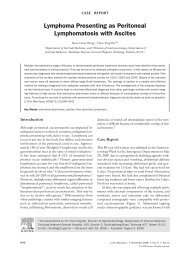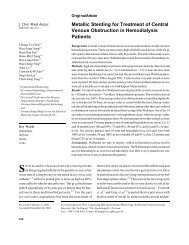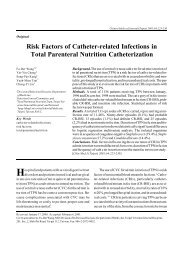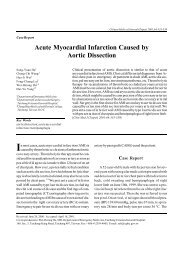Surgical Anatomy of Supratentorial Midline Lesions
Surgical Anatomy of Supratentorial Midline Lesions
Surgical Anatomy of Supratentorial Midline Lesions
Create successful ePaper yourself
Turn your PDF publications into a flip-book with our unique Google optimized e-Paper software.
from 0 to 7 (average, 1.1) per hemisphere, and their diameters ranged between 0.2 and 0.5 mm (average, 0.25)(Fig. 11 and Table 2).<br />
Posterior pericallosal artery<br />
The posterior pericallosal artery (also known as the splenial artery) contributed to the blood supply <strong>of</strong> the corpus callosum, in particular the<br />
splenial portion, in all hemispheres. It arose from the main trunk <strong>of</strong> the parieto-occipital artery or its precuneal branch (52%), the P3 segment <strong>of</strong><br />
the PCA (32%), the calcarine artery (7%), the temporo-occipital artery (7%), or the P2 segment <strong>of</strong> the PCA (2%). Three anatomic variations <strong>of</strong><br />
the posterior pericallosal artery were identified: 1) proximal type (the origin <strong>of</strong> the artery was located a few millimeters inferior to the splenium<br />
and followed an S-shaped course toward the splenium [80%]); 2) distal type (the artery generally arose from a precuneal branch <strong>of</strong> the<br />
parieto-occipital artery and was located posterior to the splenium [10%]); and 3) double type (both proximal and distal arterial patterns were<br />
observed, and they anastomosed with each other within the callosal sulcus [10%]).<br />
In all three variations, the posterior pericallosal artery divided into two main branches when it reached the splenium. The superior branch<br />
formed the main trunk and coursed within the callosal sulcus with a characteristic corkscrew-like tortuousity; it then anastomosed with the<br />
posterior extension <strong>of</strong> the A5 segment in 65% <strong>of</strong> the hemispheres. When the long callosal and/or the median callosal arteries were present, they<br />
were also occasionally involved with this anastomosis. In 35% <strong>of</strong> the hemispheres, the A5 segment coursed in the cingulate sulcus. In this<br />
instance, the median callosal and/or the long callosal arteries were dominant and anastomosed exclusively with the posterior pericallosal artery.<br />
All variations <strong>of</strong> these complex anastomoses formed the dense portion <strong>of</strong> the pericallosal pial plexus within the callosal sulcus in the splenial<br />
region. In 77.5% <strong>of</strong> the hemispheres, the inferior branch ran anteriorly and then gave rise to branches supplying the tail <strong>of</strong> the hippocampus,<br />
and/or the pulvinar <strong>of</strong> the thalamus, and/or the tela choroidea <strong>of</strong> the third ventricle. In the latter situation, it usually anastomosed with the medial<br />
posterior choroidal artery and occasionally reached as far as the foramen <strong>of</strong> Monro. In the remaining 22.5% <strong>of</strong> the hemispheres, the inferior<br />
branch was thin and short and supplied the fasciolar gyrus and the crus <strong>of</strong> the fornix. The posterior pericallosal artery ranged in number between<br />
1 and 2(average, 1.1) per hemisphere, and its diameter ranged between 0.4 and 1.0 mm(average, 0.7 mm) (Figs. 1, 7, A-C, 8, A and B, 9-11).<br />
FIGURE 7. Anatomic variations <strong>of</strong> the posterior pericallosal artery. A, proximal type. In 80% <strong>of</strong> the hemispheres, the posterior pericallosal<br />
artery (arrowhead) arises from the PCA or one <strong>of</strong> its main branches, inferior to the splenium( S). B, distal type. In an additional 10% <strong>of</strong><br />
hemispheres, the posterior pericallosal artery( arrowhead) generally arises from a precuneal branch <strong>of</strong> the parieto-occipital artery, posterior to<br />
the splenium.C, double type. In the remaining 10% <strong>of</strong> the hemispheres, both proximal and distal type arteries are present( arrowheads). In all<br />
instances, the posterior pericallosal artery courses toward the splenium, where it divides into two main branches, superior and inferior .



